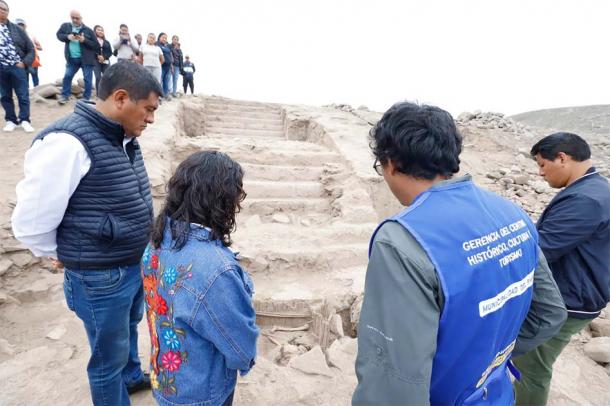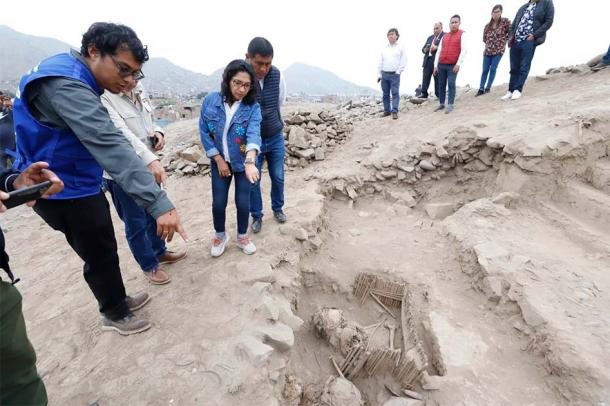In Peru, four mummified children, estimated to be over 1,000 years old, have been unearthed in what is now considered one of Lima’s oldest neighborhoods, with their skulls still having hair on them! The discovery took place in a sacred ceremonial site at Huaca La Florida, Lima, with images and footage of the find captured. Researchers suggest that these children belonged to the Ychsma culture, a pre-Inca civilization that inhabited the central coast of Peru, particularly in the Lima region. This culture flourished between approximately 1000 and 1400 AD.
Unearthing a Ceremonial Atrium: Hair and Skulls Combine
Alongside the mummies, an adult’s remains were discovered near a small hill featuring a staircase that potentially led to a concealed temple, believed to be around 3,500 years old. Three of the mummies were wrapped in textiles, while the remaining two were found as skeletons, with the aforementioned hair still present on their skulls. The archaeologists speculate it was likely that these mummies were natural burials, rather than human sacrifices.
The skeletal remains were discovered on the stairway of an adobe temple shaped like a “U,” a distinctive architectural element in pre-Inca constructions.
- Thirty Two Pre-Hispanic Mummies Uncovered in Peru
- Hundreds of Ancient Mummies Discovered at Ceremonial Site in Peru

The mummies were discovered on a stairway of the Huaca pyramid. (Peru Ministry of Culture)
“What we see here is that the whole area where we are now was a ceremonial atrium,” said Luis Takuda, an archaeologist who is leading the Huaca La Florida research project, according to Reuters. “It was a very important ceremonial atrium where the people who lived in the time of the Ychsma considered it a sacred space and therefore buried their dead here.”
Instances of mummies or skeletons with preserved hair have been documented in the past. Earlier this year, a 1,000-year-old skeleton uncovered in Peru’s Miraflores district also displayed long, well-preserved hair.
In Egypt, archaeologists made a surprising discovery when they found unwrapped mummified children with fair hair instead of the expected black or brown. A study published in 2020 by the journal Forensic Science, Medicine and Pathology reported this finding. Contrary to the hypothesis that the hair lightened due to exposure to the mineral natron used in the mummification process or post-mortem, modern hair testing indicated that the fair hair was likely a result of ancestral traits, according to the researchers, reports CBS News.
- Pre-Inca Peruvians Painted Skulls with Red Pigments
- Who Built the Ñaupa Iglesia? Mysterious Ruins in Peru’s Sacred Valley

The authorities inspect the graves containing the mummies. (Peru Ministry of Culture)
Lima: Huacas and Urban Expansion
The location in Peru where the four children were unearthed is situated in proximity to residences and a training field. The presence of huacas, or sacred sites, is a familiar sight in Lima, with approximately 400 such sites scattered across the city, according to the Ministry of Culture. Huacas are pre-Columbian sacred sites or ceremonial centers. These sites often served as places of worship, burial, and other ritual activities.
During the initial months of the year, a team of excavators diligently labored to remove an extensive amount of garbage, totaling up to eight tons, that had covered the hill’s summit. This hill is situated adjacent to the training ground and institutional headquarters of the Peruvian professional soccer team, Sporting Cristal. Municipal police officers were also tasked with the removal of homeless individuals or drug addicts who had previously sought refuge in the vicinity of the hill, reports The Associated Press.
Lima, although hosting numerous archaeological sites, is predominantly known for its historical sites located outside the city. One notable example is Cusco, the former capital of the Inca Empire until the 16th century when it was infiltrated by conquistadors. Many of Peru’s significant archaeological sites are situated in places like Cusco rather than within the confines of Lima.
Top image: Five mummified remains found in Huaca la Florida, Lima. Source: Peru Ministry of Culture





